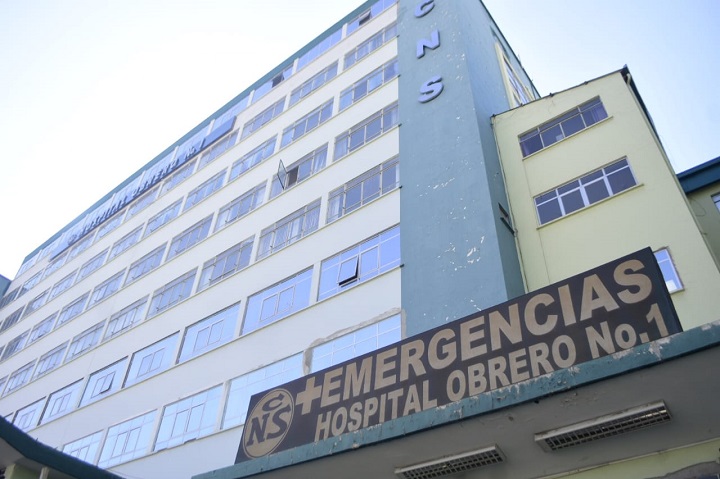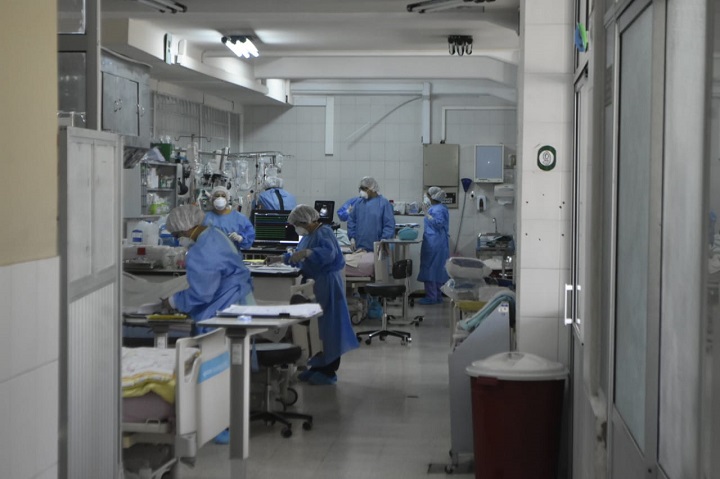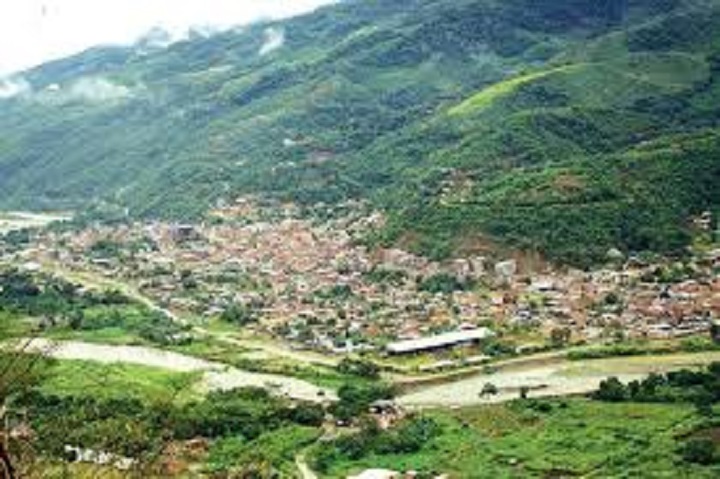Translation Google
Ministry of Health and experts rule out epidemiological emergency, the situation is controlled in the case of two doctors
La Paz - Sunday, June 30, 2019 | Communication Unit
After a three-hour meeting between seven health institutions, the area's minister, Gabriela Monta?o, reported Sunday that two hospitalized doctors suffer from an unidentified viral disease, ruling out influenza, and at the moment the situation is controlled. He also anticipated that the official information will be provided only by this State portfolio and the Departmental Health Service (Sedes) of La Paz, after follow-up with experts.
"We are going to inform the population in an adequate and official way about patients in the department of La Paz. (The two doctors) are with a diagnosis not determined, we have hypotheses as a viral disease that must be corroborated laboratorially, influenza was ruled out. We are taking all the biosecurity forecasts, the population must be calm, it is a controlled situation, "the authority said at a press conference in the city of La Paz.
The technical meeting began at 5:30 a.m. in the auditorium of the Ministry of Health with the presence of the headquarters directory, Caja Petrolera de Salud, Hospital Obrero, Hospital Arco Iris, Instituto de Gastroenterolog?a Boliviano Japon?s, the Bolivian Society of Infectious Diseases and the Pan American Health Organization - World Health Organization (PAHO / WHO).
In this context, Monta?o lamented the speculations that were propitiated in social networks because they scared the population.
"Tell the population that these are two patients who are medical colleagues who are in intensive care. These patients present signs and symptoms, that is, symptoms of fever and development of the disease, "he explained.
Biosecurity
As a preventive measure, the Ministry of Health will reinforce tonight with biosafety level 4 material to the Caja Petrolera de Salud and the Hospital Obrero, thus protecting health personnel.
The follow-up is also done to all the people who were in contact with both patients.
"These contacts are being followed up, it is advisable in these cases that those people who require it can be attended immediately and do the appropriate laboratory exams. In parallel, the National Institute of Health Laboratories (Inlasa) and the National Center for Tropical Diseases (Cenetrop) work in a coordinated manner to have a definitive diagnosis. With the work of Inlasa we hope to have an initial laboratory diagnosis in 48 hours, "he said.
With the support of the Centers for Disease Control and Prevention CDC of Atlanta, the results can be ready in 14 days and with the cooperation of the PAHO, infectious experts (clinical and laboratory) will arrive on July 1 to examine the cases.
Controlled situation
"I repeat, it is a controlled situation, there is no Epidemiological emergency in our department or in our country. Tell the population that if they have to do an exam tomorrow they should normally go to hospitals. Absolutely discard all those hypotheses that circulated through social networks, "he said.
Finally the head of Health remarked that the only official source that can be disseminated will be the Ministry of Health and the Headquarters of La Paz, other information is not real and is not official.
NES /
-----------------------------------------------------------
PAHO highlights the capacity of the country to respond to epidemiological events
La Paz - Monday, July 01, 2019 | Communication Unit
In the presence of an unidentified viral disease that affected an internal doctor in Caranavi and two doctors in the department of La Paz, the Representative of PAHO / WHO in Bolivia, Alfonso Tenorio, called on the population to trust and follow the instructions of the authorities of the national and departmental levels in order to avoid panic in the population.
"We must all follow the instructions given by the authorities, we trust those recommendations, we must follow them and be calm," said the international representative in time to highlight the response capacity of Bolivia to this type of health events.
"We highlight the capacity of the country to address these epidemiological situations that occur frequently, as it has the conditions; the team and its staff fully trained to take the diagnostic, treatment, clinical management and epidemiological control measures, "said Tenorio.
According to the PAHO / WHO, Bolivia has the basic capabilities, which the International Health Regulations (IHR) have been fulfilling for a long time, "whatever the threat ... it can be a virus, a bacterium, a parasite, a fungus or toxic threats. , the country is ready, "he said.
He also explained that there are viruses and diseases that are not easy to diagnose -as in this case- and require specialized tests.
"When it is not possible to confirm a diagnosis with the exams available in the country, the samples are sent to other countries or collaborating centers with greater capacity, that is normal and does not mean that the country does not have the conditions," said the representative of PAHO in Bolivia.
Tenorio recognized teamwork at all levels, from the central, departmental and municipal level, in addition to the participation of hospitals, the infectious disease society and other scientific societies that intervened in a timely manner, "that is very important and a guarantee for the correct attention of these eventualities ", indicated.
smh /
------------------------------------------------------------------------
Ministry of Health confirms the arrival of a specialist from Brazil for the care of viral disease
La Paz - Monday, July 01, 2019 | Communication Unit
The Minister of Health, Gabriela Monta?o, confirmed on Monday the arrival of an infectious disease specialist from Brazil, who as of Tuesday will reinforce the treatment of two doctors and three suspected cases in the department of La Paz.
"We have also requested the Pan American Health Organization (PAHO) to help us with the delivery of two other specialists who will arrive on Wednesday (July 3), one in the laboratory and the other in the clinic," the authority said at a conference. press.
These experts will join the team of Bolivian specialists, who keep the situation under control.
The Ministry of Health also reported that there are three suspected cases, which are currently hospitalized in the Caja Petrolera de Salud and the Obrero Hospital.
"We have to inform the population that we have three suspected cases, in addition to the two doctors who were already in intensive care. Two of these suspected cases are contacts of inpatients and one patient who had not had contact, but has symptoms and signs as we noted, although dengue, influenza and other viral agents were not ruled out, "said the authority.
Isolated
Monta?o stressed that it has the ability to serve the population, as well as the safety of health personnel.
"Both patients are in special rooms, special cubicles and are treated by health personnel. He also took all the level 4 biosecurity measures that we have established, "he said.
Class of patients
The Infectious Disease Society of Bolivia specified that a suspect case is defined as any person who comes from the endemic area or who has had contact with inpatients and has symptoms of headache, muscle pain, abdominal pain, etc. have leukopenia (decrease in white blood cells) and thrombocytopenia (decrease in platelets in the hemogram).
It is a probable case when the person undergoes laboratory tests and discards diseases or other possible diagnoses.
An isolated patient means that he has no contact with other patients hospitalized in the same hospital.
Finally, it is a confirmed case when the pathogen (virus) that causes the disorder of a patient is determined by laboratory.
nes /
Ministry of Health and experts rule out epidemiological emergency, the situation is controlled in the case of two doctors
La Paz - Sunday, June 30, 2019 | Communication Unit
After a three-hour meeting between seven health institutions, the area's minister, Gabriela Monta?o, reported Sunday that two hospitalized doctors suffer from an unidentified viral disease, ruling out influenza, and at the moment the situation is controlled. He also anticipated that the official information will be provided only by this State portfolio and the Departmental Health Service (Sedes) of La Paz, after follow-up with experts.
"We are going to inform the population in an adequate and official way about patients in the department of La Paz. (The two doctors) are with a diagnosis not determined, we have hypotheses as a viral disease that must be corroborated laboratorially, influenza was ruled out. We are taking all the biosecurity forecasts, the population must be calm, it is a controlled situation, "the authority said at a press conference in the city of La Paz.
The technical meeting began at 5:30 a.m. in the auditorium of the Ministry of Health with the presence of the headquarters directory, Caja Petrolera de Salud, Hospital Obrero, Hospital Arco Iris, Instituto de Gastroenterolog?a Boliviano Japon?s, the Bolivian Society of Infectious Diseases and the Pan American Health Organization - World Health Organization (PAHO / WHO).
In this context, Monta?o lamented the speculations that were propitiated in social networks because they scared the population.
"Tell the population that these are two patients who are medical colleagues who are in intensive care. These patients present signs and symptoms, that is, symptoms of fever and development of the disease, "he explained.
Biosecurity
As a preventive measure, the Ministry of Health will reinforce tonight with biosafety level 4 material to the Caja Petrolera de Salud and the Hospital Obrero, thus protecting health personnel.
The follow-up is also done to all the people who were in contact with both patients.
"These contacts are being followed up, it is advisable in these cases that those people who require it can be attended immediately and do the appropriate laboratory exams. In parallel, the National Institute of Health Laboratories (Inlasa) and the National Center for Tropical Diseases (Cenetrop) work in a coordinated manner to have a definitive diagnosis. With the work of Inlasa we hope to have an initial laboratory diagnosis in 48 hours, "he said.
With the support of the Centers for Disease Control and Prevention CDC of Atlanta, the results can be ready in 14 days and with the cooperation of the PAHO, infectious experts (clinical and laboratory) will arrive on July 1 to examine the cases.
Controlled situation
"I repeat, it is a controlled situation, there is no Epidemiological emergency in our department or in our country. Tell the population that if they have to do an exam tomorrow they should normally go to hospitals. Absolutely discard all those hypotheses that circulated through social networks, "he said.
Finally the head of Health remarked that the only official source that can be disseminated will be the Ministry of Health and the Headquarters of La Paz, other information is not real and is not official.
NES /
-----------------------------------------------------------
PAHO highlights the capacity of the country to respond to epidemiological events
La Paz - Monday, July 01, 2019 | Communication Unit
In the presence of an unidentified viral disease that affected an internal doctor in Caranavi and two doctors in the department of La Paz, the Representative of PAHO / WHO in Bolivia, Alfonso Tenorio, called on the population to trust and follow the instructions of the authorities of the national and departmental levels in order to avoid panic in the population.
"We must all follow the instructions given by the authorities, we trust those recommendations, we must follow them and be calm," said the international representative in time to highlight the response capacity of Bolivia to this type of health events.
"We highlight the capacity of the country to address these epidemiological situations that occur frequently, as it has the conditions; the team and its staff fully trained to take the diagnostic, treatment, clinical management and epidemiological control measures, "said Tenorio.
According to the PAHO / WHO, Bolivia has the basic capabilities, which the International Health Regulations (IHR) have been fulfilling for a long time, "whatever the threat ... it can be a virus, a bacterium, a parasite, a fungus or toxic threats. , the country is ready, "he said.
He also explained that there are viruses and diseases that are not easy to diagnose -as in this case- and require specialized tests.
"When it is not possible to confirm a diagnosis with the exams available in the country, the samples are sent to other countries or collaborating centers with greater capacity, that is normal and does not mean that the country does not have the conditions," said the representative of PAHO in Bolivia.
Tenorio recognized teamwork at all levels, from the central, departmental and municipal level, in addition to the participation of hospitals, the infectious disease society and other scientific societies that intervened in a timely manner, "that is very important and a guarantee for the correct attention of these eventualities ", indicated.
smh /
------------------------------------------------------------------------
Ministry of Health confirms the arrival of a specialist from Brazil for the care of viral disease
La Paz - Monday, July 01, 2019 | Communication Unit
The Minister of Health, Gabriela Monta?o, confirmed on Monday the arrival of an infectious disease specialist from Brazil, who as of Tuesday will reinforce the treatment of two doctors and three suspected cases in the department of La Paz.
"We have also requested the Pan American Health Organization (PAHO) to help us with the delivery of two other specialists who will arrive on Wednesday (July 3), one in the laboratory and the other in the clinic," the authority said at a conference. press.
These experts will join the team of Bolivian specialists, who keep the situation under control.
The Ministry of Health also reported that there are three suspected cases, which are currently hospitalized in the Caja Petrolera de Salud and the Obrero Hospital.
"We have to inform the population that we have three suspected cases, in addition to the two doctors who were already in intensive care. Two of these suspected cases are contacts of inpatients and one patient who had not had contact, but has symptoms and signs as we noted, although dengue, influenza and other viral agents were not ruled out, "said the authority.
Isolated
Monta?o stressed that it has the ability to serve the population, as well as the safety of health personnel.
"Both patients are in special rooms, special cubicles and are treated by health personnel. He also took all the level 4 biosecurity measures that we have established, "he said.
Class of patients
The Infectious Disease Society of Bolivia specified that a suspect case is defined as any person who comes from the endemic area or who has had contact with inpatients and has symptoms of headache, muscle pain, abdominal pain, etc. have leukopenia (decrease in white blood cells) and thrombocytopenia (decrease in platelets in the hemogram).
It is a probable case when the person undergoes laboratory tests and discards diseases or other possible diagnoses.
An isolated patient means that he has no contact with other patients hospitalized in the same hospital.
Finally, it is a confirmed case when the pathogen (virus) that causes the disorder of a patient is determined by laboratory.
nes /






Comment